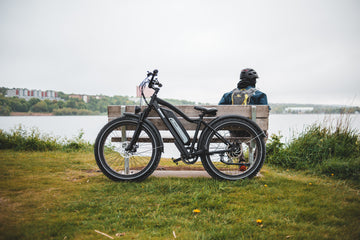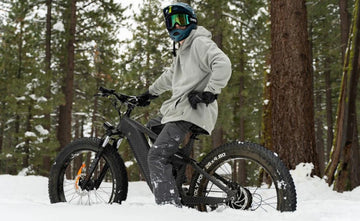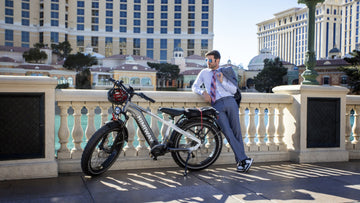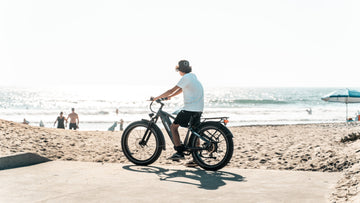Trail riding is one of America's favorite sports because it's a great way to explore the outdoors and exercise. But if you've taken a long trail riding break, you might feel apprehensive about returning to it. This is because trail riding requires good fitness and riding skills. If you've been out of practice for a while, you may tire more quickly, and your riding skills have become rusty.
It’s also possible to feel less confident in your abilities if you've been away from trail riding for a while. You may be worried that you won't be able to keep up with other riders or make a mistake.
Instead of letting this stop you, getting back on the trail with your Himiway e-bike can be rewarding. Don’t worry; we’ve got you covered. This piece will show you seven verified and valuable tips to get back into trail riding after a long break. After reading, you will have enough information to jump on your e-bike and go trail riding again.

Assessing Your Fitness and Skill Level
E-bikes are relatively easy to ride, but it’s necessary to have some basic cycling skills, such as braking and shifting gears. Also, if you are not used to exercising regularly, you may want to start with shorter, more leisurely rides and gradually increase the distance and difficulty as you get stronger.
Importance Of Assessing Your Current Fitness Level
You need to assess your current fitness level before hitting the trails with e-bikes because of these:
Safety:
E-bikes can travel at higher speeds than traditional bicycles, so it’s important to control the bike and react quickly to changes in terrain and traffic. You may be more likely to have an accident if you are not in good physical condition.
To avoid overexerting yourself:
E-bikes can make riding faster and much easier than a traditional bicycle. If you are not in good physical condition, you may be more likely to overexert yourself, leading to fatigue, injuries, and illness.
To choose the right e-bike:
Various e-bikes with different motor power, battery capacity, and other features are available. Your e-bike must be appropriate for your fitness level and riding needs.
To prevent injuries:
Riding an e-bike can be strenuous, especially if you are not used to it. If you start riding too hard too soon, you are more likely to get injured.
To set realistic goals:
If you are new to e-biking, setting realistic goals for yourself is necessary. Don't try to ride too far or too fast too soon. As you get more experienced, you can gradually increase the distance and difficulty of your rides.
How Himiway's Long-Range Electric Bikes Ease You Back Into Riding
Himiway electric bikes have various riding modes to assist in easing back into riding:
Pedal assist:
HIMIWAY e-bikes have a pedal assist feature that provides power to the motor during pedaling. This can make it easier to ride on hills and long distances.
Throttle:
You also get a throttle, which allows you to ride without pedaling. It can be helpful if you need to take a break or are riding on a challenging section of trail.
Long range:
These e-bikes have long-range batteries, so you can ride longer without worrying about running out of power.
Evaluating Trail Riding Skills
You might be wondering how you can measure your trail riding skills; here are some tips to help:
Identify Your Strengths And Weaknesses:
What are you good at? What do you need to improve on? Once you know your strengths and weaknesses, you can focus on improving the areas where you need the most work.
Bike handling:
How well can you control your e-bike on different types of terrain, such as loose dirt, rocks, and roots? Can you safely navigate tight corners and steep hills?
Speed management:
Can you adjust your speed appropriately for the conditions and your surroundings? Can you safely descend steep hills and brake quickly if necessary?
Awareness:
Are you aware of your surroundings and other riders on the trail? Can you anticipate hazards and take evasive action if necessary?
Himiway's E-Bike Features To Enhance Your Riding Experience
Himiway e-bikes have several features that can make your riding experience a much easier one, including:
Powerful motor:
With Himiway, you can get an e-bike equipped with a powerful 750W motor that can easily handle hills and rough terrain. This ensures you can pedal less and enjoy the ride more.
Large battery:
The Himiway Cobra Electric Mountain Bike has a large 48V 20Ah battery that provides up to 80 miles of range on a single charge. With this, you have plenty of power to complete your trails without stopping to charge midway.
Fat tires:
The Himiway mountain e-bike has 4.8" fat tires that provide excellent traction and stability on all types of terrain. It offers a confident ride in mud, sand, and snow. With fat tires, you can be more versatile with your trails.
Full-suspension fork:
You will likely ride through rough terrains, so you need something to cushion the impacts of rough roads and potholes. Himiway e-bikes have a full-suspension fork that absorbs bumps and shocks, providing a smooth and comfortable ride.
Selecting the Right Trail and Ride Duration
We’ve discussed evaluating your fitness level and trail riding skills; let’s discuss selecting the right trail and ride duration.
Choosing Beginner-Friendly Trails
Here are some beginner-friendly trails that are suitable for you if you are getting back into trail riding:
Fire roads:
Fire roads like the Angeles Crest Highway in Southern California are generally wide and well-maintained, making them ideal for beginner riders. They can also be an excellent way to check out new areas and get a feel for the terrain before attempting more challenging trails.
Rails-to-trails:
Rails-to-trails are typically flat and wide, and they often offer scenic views. You can check out the C&O Canal Towpath in Maryland and Virginia.
Green trails:
Green trails are the easiest type of mountain bike trail. An example is the Little Sugar Creek Greenway in Charlotte, North Carolina, which is typically smooth and free of technical features.
Blue trails:
Blue trails are more challenging than green trails but are still suitable for beginner riders. The North Table Mountain Trail in Golden Gate Park, San Francisco, may have some technical features, such as rocks and roots, but it is relatively easy to navigate.
Himiway electric fat tire bikes are well-suited for various terrains, including fire roads, rails-to-trails, green trails, blue trails, and even intermediate trails. Their fat tires provide excellent traction and stability on all types of surfaces, and their powerful motors make it easy to climb hills and ride over rough terrain.
Start with Shorter Rides
Starting with shorter rides will gradually help you build your endurance and confidence. As you get stronger and more comfortable, you can gradually increase the distance and difficulty of your rides.
With Himiway electric bikes, you can easily climb hills, ride over rough terrain, and enjoy the outdoors without getting as tired. You can also see new places you wouldn't be able to reach on a regular mountain bike and have a more enjoyable and relaxing ride.
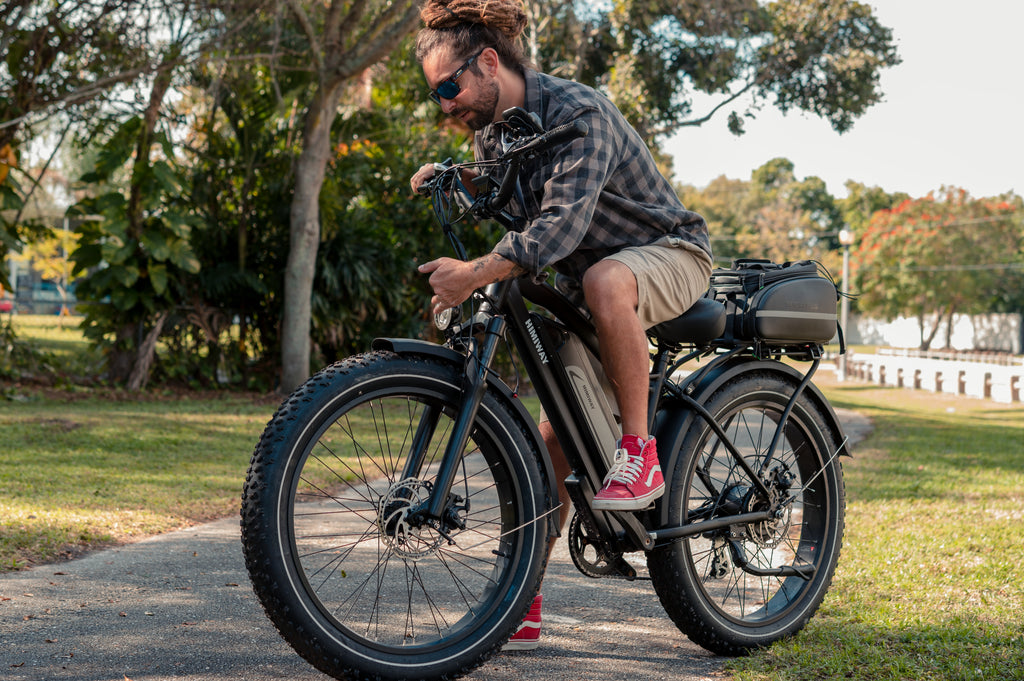
Preparing Your Electric Fat Tire Bike
Make it a habit always to check your electric fat tire bike before each ride and ensure it’s in good working condition. This helps to prevent any accidents or problems on the trail. Here are some of the things you should check:
Tires: Ensure that your tires are properly inflated and that there are no tears or punctures.Brakes: Test your brakes to ensure they are working well.
Chain: Make sure that your chain is clean and lubricated.
Gears: Shift through all your gears to ensure they work properly.
Lights: If you ride at night or in low light conditions, ensure your lights work properly.
Battery: Ensure your battery is charged and the charging port is secure.
Motor: Ensure the motor is turned on and working correctly.
Display: Check if the display works properly and shows the correct information.
Himiway's Quality and Durable Components
Every part of the Himiway electric bike has high-quality and durable components. This means you can be confident that your bike can handle the rigors of trail riding. These components include:
Frame:
Himiway electric bikes have a durable aluminum frame that is lightweight and strong. The frame is also designed for optimal comfort and performance, with a low center of gravity for stability and a comfortable riding position.
Motor:
Himiway e-bikes boast powerful Bafang motors that can handle terrain. The motors are also very efficient so you can ride longer distances on a single charge.
Battery:
These e-bikes also use high-quality Samsung or LG batteries that provide a long range. The batteries are also well-protected from the elements so that you can ride in any weather.
Drivetrain:
Himiway electric bikes are equipped with Shimano gears and drivetrain components. This ensures that the bike is reliable and easy to shift.
Brakes:
Himiway electric bikes are equipped with Tektro hydraulic disc brakes. These brakes provide powerful and responsive braking, even in wet or muddy conditions.
Checking Battery and Tire Pressure
Before every ride, you should check your battery charge levels and tire pressure to ensure optimal performance.
Battery Charge Levels:
A fully charged battery will give you the best possible performance and range. If your battery is low, you cannot go as far or ride as fast. It is also important to avoid running your battery completely dead, as this can damage it.
Tire Pressure:
Proper tire pressure is essential for maintaining good traction and handling. If your tires are underinflated, you will have more rolling resistance, making it harder to pedal and reduce your range. Overinflated tires can also be dangerous, as they are more likely to pop.
Himiway's Smart Display Features:
Himiway electric fat tire bikes come with smart display features that allow you to monitor your battery levels in real-time. This makes it easy to ensure that your battery is always charged and you will have enough power for your ride.
Gradually Building Endurance and Skill
Himiway electric fat tire bikes come with various power-assist modes to gradually help you progress your skills. The power-assist modes allow you to choose how much assistance you want from the motor, from no assistance to full assistance. These tips should help:
1. Start with the lowest power-assist mode and gradually increase the power-assist as you get stronger and more comfortable.2. Use the power assist to help you climb hills and ride over rough terrain.
3. You can use less power assist as you get stronger and more comfortable.
4. The goal is to be able to ride without power-assist, but it is okay to use it when you need it.
5. Be patient. It takes time to build endurance and skill. Keep going even if you don't see results immediately.
6. Be consistent and ride regularly to improve your endurance and skill.
Listen to your body, and don't push yourself too hard, especially when starting.
Incorporating Training Rides and Exercises
In addition to riding trails, incorporating training rides and exercises into your routine is also a good idea. This helps you build strength and endurance, making you a better trail rider.
Training Rides
Training rides can be anything from a short, easy ride to a long, challenging ride. The type of training ride you do will depend on your goals and fitness level.
Here are some examples of training rides:
Interval training: Interval training is a great way to improve cardiovascular fitness. It involves alternating between periods of high-intensity exercise and periods of low-intensity exercise.
Hill repeats: Hill repeats are a great way to build leg strength and endurance. It involves riding up a hill multiple times.
Long rides: Long rides are a great way to improve your fitness and endurance.
Training Exercises
In addition to riding your bike, you can also do strength training exercises to improve your performance on the trail. Some good exercises for trail riders include:
Squats: Squats are a great way to build leg strength.Lunges: Lunges are another great way to build leg strength and stability.
Push-ups: Push-ups are a great way to build upper body strength.
Core exercises: Core exercises, such as planks and crunches, are important for maintaining balance and stability on the trail.
Himiway's Pedal-Assist and Power-Assist Features for Customized Workout Sessions
Himiway electric fat tire bikes come with power-assist features that allow you to customize your workout sessions. The pedal-assist feature assists while riding.
1. Use the pedal-assist feature to help you climb hills and ride over rough terrain.2. Use the power-assist feature to give yourself a break or to help you ride longer distances.
3. Experiment with pedal-assist and power-assist modes to find the best for you.
4. Listen to your body, and don't push yourself too hard.
Practicing Safety Measures
You need to wear proper protective gear while trail riding to protect yourself from injuries in the event of a fall. Some of the essential pieces of protective gear for trail riding include:
Helmet: The helmet is the most important protective gear for trail riding to protect your head from serious injuries in a fall.
Goggles: Goggles protect your eyes from dirt, dust, and other debris, especially when riding in dry or dusty conditions.
Gloves: Gloves protect your hands from abrasions and blisters and provide grip and control, which is important for riding on rough terrain.
Long pants: These are to protect your legs from scratches, scrapes, and other injuries.
Long-sleeved shirt: A long-sleeved shirt protects your arms from scratches, scrapes, and sunburn.
Joining a Riding Group or Taking Lessons
Riding with a group can be a great way to stay motivated and get guidance from more experienced riders. Riding groups can also provide a sense of camaraderie and support. You also get:
Motivation: Riding with a group can help you to stay motivated. Seeing other riders pushing themselves can inspire you to do the same.Guidance: More experienced riders can guide everything from the right trail to the riding technique.
Safety: Riding with a group can be safer than riding alone. If someone has an accident, other riders can help.
Camaraderie: Riding with a group can be a lot of fun. It is a great way to meet new people and make friends who share your passion for riding.
Support: Riding groups can provide support for their members. This can include helping with bike repairs or providing transportation to and from the trail.
Conclusion
It is not impossible to enjoy your first trail riding after a long break; you need to start with shorter rides and gradually increase the distance as you get stronger and more comfortable. Check your bike before each ride and ensure it is in good working condition. Wear proper protective gear, such as a helmet, goggles, gloves, long pants, and a long-sleeved shirt. Ride within your skill and comfort levels. Join a riding group or take lessons for motivation and guidance.
Use Himiway's electric fat tire bikes' pedal-assist and power-assist features to customize your workout sessions and build strength and endurance. Be patient and take your time. It takes time to build endurance and skill. Have fun; trail riding is supposed to be enjoyable. Put less pressure on yourself to perform or ride the most challenging trails. Just relax and enjoy the ride.















